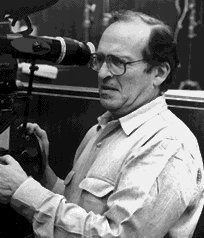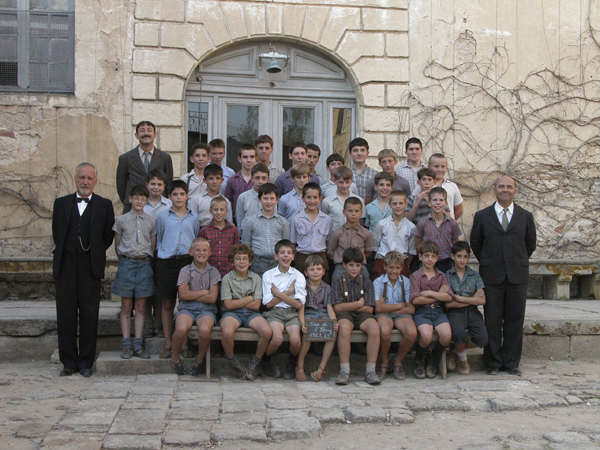...the filmmakers initially developed their project with Paul Newman in mind. He would portray a handsome, cultivated bon vivant, once a paratrooper in Indochina, now a magazine reporter assigned to cover France’s latest imperial adventure in the Casbah. We can purely speculate on the rest—how our hero’s journalistic sangfroid might have crumbled before the worst Gaullist outrages, his vanity and complacency challenged by self-scrutiny, doubt, and progressive awareness of guilt....LINK
...Psychology was a red herring. The Algerians had, after all, waged a political campaign in response to a collective experience of injustice. The revised film would chronicle nothing less than the battle of an entire nation for selfhood...
Monday, March 28, 2005
Bombs and Boomerangs
The Battle of Algiers and Its Lessons
The film has the grainy look of a documentary, but as the opening trailer proudly proclaims, not a foot of newsreel was actually used.LINK
The Pentagon's Film Festival - A Battle of Algiers Primer
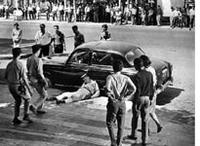
From its first release, the film was extremely controversial: When the film was finally shown in France, theaters were bombed. In Italy, viewers were attacked.
Many sequences are meticulously accurate, such as the famous one referred to by the Pentagon in its flier, in which Algerian women put on Western clothes and makeup and then plant bombs at civilian French targets. Unsurprisingly, many characters are composites, and numerous details are fudged, made up, or altered. Among them is Ali's powerful last line in the film, directed at the French: "I do not negotiate with them." The line is actually appropriated from a speech by then-Interior Minister Francois Mitterand, who had directed it at the insurgents. LINK
Battaglia di Algeri, La (1965)
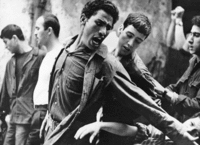 Peter's Nite
Peter's NiteSalad, Pizza, Warm (ish) Apple Pie
The Guardian: Few fictional films look more like documentary than Gillo Pontecorvo's The Battle of Algiers, and very few indeed which have this kind of socio-political structure and recount old, half-forgotten conflicts have achieved such lasting fame.
We know, of course, that Algeria was eventually liberated from the French, but Pontecorvo relegates that to an epilogue. He concentrates instead on the years between 1954 and 1957 when the freedom fighters regrouped and expanded into the casbah, only to face a systematic attempt by French paratroopers to wipe them out. His highly dramatic film is about the organisation of a guerrilla movement and the methods used to decimate it by the colonial power.Its stance is as fair as any such film could be, despite the fact that Pontecorvo was a member of the Italian communist party at the time and thus was implicitly on the side of the independence movement. There is, though, no caricature and no glamorisation of either side - just a feeling of palpable horror evoked by urgent images and Ennio Morricone's dramatic but never melodramatic score. Pontecorvo sees the colonialists as victims of their own system, and the rebels as taking on some of the excesses used against them.
In one scene, a group of ordinary people, French and Algerian, are enjoying coffee and conversation near the casbah when a rebel bomb explodes among them. The shock of this sequence is even worse than the scenes of the French using torture.
The film is preceded by a message from the film-maker stating that "not one foot" of newsreel footage was used, but Marcello Gatti's grainy, black-and-white camera work in the actual locations of the struggle, and the pioneering use of a hand-held camera for the crowd scenes, makes it seem as if events are being recorded as they occur. The mixture of amateurs and professionals in the cast works admirably too.
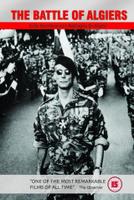
Bombs and Boomerangs - Peter Matthews: "....the filmmakers initially developed their project with Paul Newman in mind.
He would portray a handsome, cultivated bon vivant, once a paratrooper in Indochina, now a magazine reporter assigned to cover France’s latest imperial adventure in the Casbah. We can purely speculate on the rest—how our hero’s journalistic sangfroid might have crumbled before the worst Gaullist outrages, his vanity and complacency challenged by self-scrutiny, doubt, and progressive awareness of guilt. Then he would, perhaps, experience the birth of consciousness and a final, ardent dedication to the rebel cause. Whether Pontecorvo and Solinas held these or other cards up their sleeves, the resulting movie would almost certainly have been a compromise. You can understand the logic.A “difficult” subject demands the warranty of a box-office name to pacify backers and entice a wide audience, who will hopefully learn a thing or two. But the fact remains that Parà (the title of Solinas’ original treatment) is a story about Paul Newman’s inner turmoil and only secondarily relates the far more ponderable misery of the Algerian people. That was the trenchant critique posed by Salah Baazi, a representative of the exiled Front de Libération Nationale (FLN), when he arrived in Italy to discuss the script. FLN military chief Saadi Yacef had envisaged his own revolutionary epic and with Baazi, was now shopping around for a suitable director. The collaborators had sidelined the independence movement in dramatizing its impact on a single European (to be played by an American). Baazi submitted an alternative script written by Yacef, which Pontecorvo rejected in turn as “sickeningly propagandistic.” Clearly a new approach was needed that would avoid the reciprocal snares of well-meaning foreign patronage and indigenous saber-rattling—bring the anger and grim resolve of the combatants viscerally close, but preserve a critical distance. In short, a creative synergy between First and Third Worlds."
Kevin Beary: Like many other Italian communists who left the party in disgust at the Soviet invasion of Hungary, however, Pontecorvo did not abandon his communist convictions. Which brings us to Battle of Algiers. Algerian independence was declared and recognized in 1962, and Pontecorvo and his collaborator Franco Solinas, Bignardi writes, were "fascinated by the events and their ideological implications, convinced that the anti-colonial struggle was an urgent and important subject, almost a symbol and model for the political struggle against ‘an invincible capitalism in Italy,’" as Solinas put it in an interview.
In 1964, a representative of military head of the FLN leader Jacef Saadi (who in the film plays the part of the FLN commander Kader) arrived in Italy looking for a leftist director to make a film about the struggle for Algerian independence and decided on Pontecorvo. In 1965, the government of Algeria gave the director "not only all the necessary permits to shoot the film in Algiers, but put at his disposal – though not completely without charge – the Algerian army for the crowd scenes."
Monday, March 21, 2005
Portrait of Jennie (1948)
 Nora's Nite
Nora's NiteBuffalo Hamburgers, Birthday Cake
(This was the last Hollywood film for Selznick -- a mere 9 years after Gone With The Wind, before age 50 -- and he was basically finished, burned out.)
American Masters: David O. Selznick:
"On December 10, 1938, David O. Selznick burned down Atlanta. On the back of his Culver City studio, Selznick had begun filming what would be his and Hollywood’s greatest triumph, GONE WITH THE WIND. Selznick was just thirty-six years old and already a legend. He had run a major studio before the age of thirty and created his own studio by the time he was thirty-three. With a harsh and controlling demeanor, he dominated every film he made. In a town of Mayers, Zanucks, and Goldwyns, David Selznick was king. But one of his most lasting contributions would have nothing to do with his grand, southern epic. Instead, it would be bringing to America a rotund, quiet director who was the shining star of British cinema. In the summer of 1939, David Selznick brought Alfred Hitchcock to Hollywood."
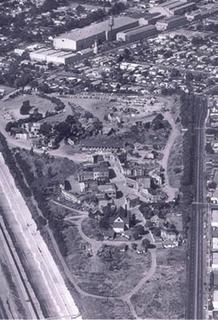
Hollywood Renegade:
"David O. Selznick was the son of industry pioneer Lewis J. Selznick, and the beneficiary of a childhood immersion in independent film production. The Selznick patriarch L. J. Selznick had been a formidable independent producer in the early days of Hollywood. He crossed paths with Carl Laemmle at Universal, and then ushered in a new age of Wall Street investment at the World Film company. In 1915 L. J. Selznick left World to become an independent, taking with him World's biggest star Clara Kimball Young. Later Selznick partnered with Adolph Zukor, only to return to independent production as the head of Selznick Pictures. David, born in 1902 was training in film production from an early age, while his older brother Myron was being groomed to someday run the Selznick Corporation. But before David came of age, his father suffered a devastating turn of events that brought the Selznick organization to ruins during the silent era."
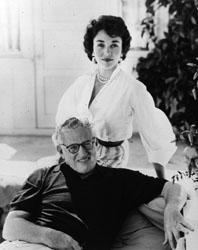
Iconic Producer of the Golden Age:
"After Gone With the Wind, Selznick spent the rest of his career trying to top that landmark achievement. The closest he came was with Duel in the Sun (1946). With a huge budget, the film is renowned for its steller cast, its sweeping cinematography and for causing all sorts of moral upheaval because of the then risque script written by Selznick. And though it was a troublesome shoot with a number of directors, the film would turn out to be a major success. The film was the second highest grossing film of 1947 and turned out to be the first movie that Martin Scorcese would see, inspiring the director's brilliant career.
Selznick spent most of the 1950s obsessing about nurturing the career of his wife Jennifer Jones. His last big budget production, A Farewell to Arms (1957) which starred Jones and Rock Hudson, was ill received. But in 1954, he ventured successfully into television producing a two hour extravaganza called Light's Diamond Jubilee, which, in true Selznick fashion, made TV history by being telecast simultaneously on all networks.
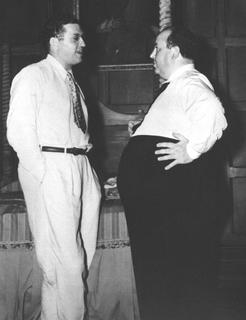
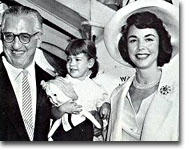
In addition to being a talented producer, Selznick had a keen instinct for new talent and will be remembered for introducing American movie audiences to Fred Astaire, Katharine Hepburn, Gregory Peck, Joan Fontaine and Jennifer Jones. He also brought many foreign actors to Hollywood, such as Ingrid Bergman, Vivien Leigh, Louis Jourdan, Alida Valli and Hildegard Knef as well as director Alfred Hitchcock.
Selznick married Irene Gladys Mayer, daughter of MGM mogul, Louis B. Mayer in 1930. They divorced in 1948. They had two sons, Daniel Selznick and Jeffrey Selznick.
Selznick married actress Jennifer Jones in 1949. They had one daughter, Mary Jennifer Selznick, who committed suicide in 1975."
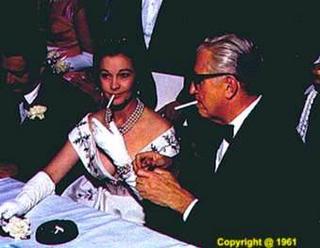

Sunday, March 13, 2005
Tuesday, March 08, 2005
Current list of movies we've seen
Can you believe it?
1. $
2. 1,000 Clowns
3. 12 Angry Men
4. 400 Blows, The
5. Accused, The
6. African Queen, The
7. After the Thin Man
8. Alfie
9. All Quiet on the Western Front (1931)
10. All That Jazz (1979)
11. All The King's Men
12. All the President's Men
13. American Graffiti
14. An American in Paris
15. And Justice For All
16. Animal House (1978)
17. Ask Any Girl
18. Atomic Cafe, The (1982)
19. Awful Truth, The (1937)
20. Bad Day at Black Rock
21. Ball of Fire
22. Bang the Drum Slowly
23. Bedazzled
24. Being There
25. Big Easy, The (1987)
26. Big Sleep, The
27. Black Narcissus (1947)
28. Black Stallion, The (1979)
29. Black Sunday (1977)
30. Blazing Saddles
31. Bonnie and Clyde
32. Born Free (1966)
33. Breaker Morant
34. Breakfast Club, The (1985)
35. Breaking Away
36. Brief Encounter
37. Bullitt
38. Cabaret
39. Caddyshack (1980)
40. Caine Mutiny, The
41. California Split (1974)
42. Candidate, The
43. Capturing the Friedmans (2003)
44. Carnal Knowledge (1971)
45. Carry On Doctor
46. Catch 22
47. Charade
48. Chariots of Fire
49. China Syndrome, The (1979)
50. Choristes, Les (2004)
51. Christmas in July
52. Ciociara, La
53. Citizen Kane
54. Coal Miner's Daughter
55. Color of Money, The
56. Cool Hand Luke
57. Day of the Jackal
58. Day the Earth Stood Still, The (1951)
59. Days of Heaven
60. Defiant Ones, The
61. Deliverance
62. Desk Set
63. Diabolique
64. Diary of a Chambermaid
65. Dinner at Eight (1933)
66. Diva
67. Dog Day Afternoon
68. Donnie Darko
69. Double Indemnity
70. Downhill Racer
71. Dream Life of Angels, The
72. Du rififi chez les hommes (Rafifi)
73. Duellists, The (1977)
74. Easy Rider
75. Enter the Dragon
76. Escape from New York
77. Fahrenheit 9/11 (2004)
78. Ferris Bueller's Day Off (1986)
79. First Blood
80. Five Easy Pieces
81. Footlight Parade (1933)
82. Foxy Brown
83. From Here to Eternity
84. Funny Face
85. Gallipoli
86. Garden of the Finzi-Continis , The
87. Gaslight
88. Gentlemen Prefer Blondes
89. Get Carter
90. Goodbye Girl, The
91. Grand Illusion
92. Great Expectations
93. Great Gatsby, The
94. Great McGinty, The
95. Gregory's Girl (1981)
96. Guess Who's Coming to Dinner
97. Gunga Din (1939)
98. Hard Day's Night, A (1964)
99. Hell in the Pacific
100. High Noon
101. Hot Rock, The (1972)
102. How to Marry a Millionarie
103. Hustler, The
104. I Know Where I'm Going
105. I'm All Right Jack (1959)
106. In the Heat of the Night
107. Incredible Mr. Limpet, The (1964)
108. Inherit the Wind (1960)
109. Ipcress File, The
110. Jules and Jim
111. King and I, The
112. King Solomon’s Mines
113. Kiss Me Kate (1953)
114. Kitty Foyle
115. Klute
116. Ladri di Biciclette (The Bicycle Thief)
117. Ladykillers, The
118. Last Detail, The
119. Last Picture Show, The
120. Laura (1944)
121. Lavender Hill Mob, The
122. Legend
123. Lenny
124. Life of Brian
125. Little Foxes, The
126. Long Goodbye, The (1973)
127. Longest Yard, The (1974)
128. Lost Horizon (1937)
129. Lost Weekend, The (1945)
130. Love Story
131. M
132. Man and a Woman, A (Un homme et une femme)
133. Marathon Man
134. Mary Poppins
135. Mata Hari (Greta Garbo version)
136. Meet Me in St. Louis (1944)
137. Mildred Pierce (1945)
138. Miracle at Morgan's Creek
139. Monster, The
140. Monty Python and the Holy Grail
141. Mr. Deeds Goes to Town
142. Mr. Smith Goes to Washington (1939)
143. Mrs. Miniver (1942)
144. Music Lovers, The
145. My Man Godfrey
146. Network
147. Now, Voyager
148. Nuit américaine, La (1973)
149. Odd Couple, The
150. Odessa File, The
151. OhayÙ (Good Morning!) (1959)
152. Old Yeller (1957)
153. Omen, The
154. One Flew Over the Cuckoo's Nest
155. Open Your Eyes
156. Paper Chase, The
157. Passport fo Pimlico
158. Paths of Glory
159. Pierrot le Fou
160. Pillow Talk
161. Place in the Sun, A
162. Planet of the Apes
163. Play Misty for Me
164. Point Blank
165. Ponette
166. Poseidon Adventure, The
167. Pretty in Pink (1986)
168. Prime of Miss Jean Brodie, The (1969)
169. Prince of Egypt
170. Prisoner of Zenda, The
171. Private Life of Sherlock Holmes, The (1970)
172. Professionals, The
173. Purple Noon
174. Rebecca
175. Ridicule
176. Risky Business (1983)
177. Roaring Twenties, The (1939)
178. Rocky
179. Roger & Me (1989)
180. Rollerball (1975)
181. Roman Holiday
182. Rosemary's Baby
183. Rutles, The
184. Salvador
185. Say Anything...
186. Scarface (1983)
187. School for Scoundrels
188. Serpico
189. Seven Days in May
190. Shaft
191. Shampoo
192. She Wore a Yellow Ribbon
193. Shining, The (1980)
194. Shop Around the Corner, The
195. Silent Partner
196. Sin of Madelon Claudet, The
197. Singing In The Rain
198. Slapshot
199. Some Like It Hot
200. Spetters (1980)
201. Spy Who Came In from the Cold, The (1965)
202. Streetcar Named Desire, A
203. Stuntman, The
204. Sweet Smell of Success
205. Swiss Family Robinson
206. Taxi Driver
207. Tequila Sunrise (1988)
208. Theater of Blood
209. Thin Man, The (1934)
210. Third Man, The
211. Thomas Crown Affair, The
212. Three Faces of Eve
213. Time Out (Emploi du temps)
214. T-Men
215. To Catch A Thief
216. To Live and Die in LA
217. Tom Jones (1963)
218. Tootsie
219. Top Hat
220. Topper (1937)
221. Train, The
222. Treasure of the Sierra Madre
223. True Grit
224. Turning Point, The (1977)
225. Twentieth Century, The
226. Ugetsu
227. Umbrellas of Cherbourg
228. Urban Cowboy (1980)
229. Viva Las Vegas (1964)
230. Wait Until Dark (1967)
231. Way We Were, The (1973)
232. West Side Story (1961)
233. Whatever Happened to Baby Jane?
234. Woman of the Year (1942)
235. Women on the Verge of a Nervous Breakdown
236. Xanadu (?!?!)
237. Year of Living Dangerously, The
238. Z (1969)
Sunday, March 06, 2005
Subscribe to:
Comments (Atom)


